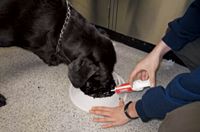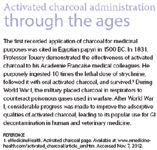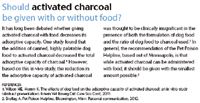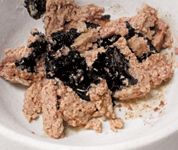When and how to use activated charcoal
Learn when decontamination with activated charcoal will benefit your patients and how to best administer it.
Using charcoal for medicinal purposes has a long history (see the sidebar "Activated charcoal administration through the ages"). More recently, activated charcoal has been used to treat toxic ingestions and continues to be a form of gastrointestinal (GI) decontamination for poisoned patients—both human and animal.1,2 But now this use has largely declined in human medicine in favor of other treatment modalities (e.g. hemodialysis, plasmapheresis). In veterinary medicine, is the use of activated charcoal still appropriate?

Photo courtesy of Garret Pachtinger, VMD, DACVECC
HOW IT WORKS
To be effective, activated charcoal must physically come into contact with the toxicant.1 Because activated charcoal has a large surface area, it is able to adsorb many chemicals and drugs through ion-ion hydrogen binding, dipole, and van der Waals forces in the upper GI tract,3 preventing or reducing the toxicant's systemic absorption. The effectiveness of adsorption is related to molecular size and polarity of the molecules, with nonpolar compounds binding to activated charcoal well.1,3 Other factors influencing adsorption of toxicants to activated charcoal include the solubility of the poison, the presence of inorganic salts, the ionization state of the poison, the pH of the toxicant, and the presence of gastric contents.1,3

Activated charcoal administration through the ages
To maximize adsorption of the toxicant, activated charcoal should be administered as soon as possible after the exposure, as delayed administration can reduce its effectiveness.1 This reduction in effectiveness will vary according to the absorption rate of the toxicant ingested and overall gastric motility.
TO GIVE OR NOT TO GIVE?
The American Academy of Clinical Toxicology (AACT) and the European Association of Poisons Centres and Clinical Toxicologists (EAPCCT) created a position paper in 1997 (revised in 2004) that stated, "Single-dose activated charcoal should not be administered routinely in the management of poisoned patients... [as]... there is no evidence that administration of activated charcoal improves clinical outcome."1 Since then, the use of activated charcoal in human medicine has declined from 7.7% in 1995 to 5.9% in 2003, according to the American Association of Poison Control Centers Toxic Exposure Surveillance System.1 Despite the move in human medicine away from activated charcoal administration,1 the question of whether to continue to administer activated charcoal as part of the detoxification of poisoned patients still exists in veterinary medicine.2
Evidence
Numerous studies in people and animals have evaluated activated charcoal administration and its efficacy based on the timing of ingestion. In the position paper on single-dose activated charcoal, human volunteer studies demonstrated that the effectiveness of activated charcoal administration decreased as time since exposure increased.1

Effectiveness of single-dose activated charcoal administration in people*
Table 1 presents the results of 122 comparison studies in people that evaluated 46 drugs (e.g. acetaminophen, amiodarone, carbamazepine, fluoxetine, phenylbutazone, phenytoin, theopylline, verapamil), the absolute amount of charcoal administered (0.5 to 100 g), and the time of administration (up to 360 minutes after ingestion).1 Unfortunately, in these studies, certain factors could not be controlled, such as the influence of food in the stomach or the presence of a toxicant that may delay gastric emptying.1
Limited veterinary literature exists. Most of the animal studies were performed in mice and rats, not in dogs and cats. It is important to consider the differences in the patients' comparative anatomy, metabolism, GI motility, and morphology, as well as the toxicant's absorption rate and site, and route of elimination.1 A recent prospective study evaluated the effect of activated charcoal administration alone vs. emesis and activated charcoal administration in dogs after an experimental overdose of carprofen and found that activated charcoal administration alone was as effective as the combination was.4
People vs. animals
Based on the results of these studies, the administration of activated charcoal to people beyond an hour of exposure is generally not recommended; however, the potential benefit when given beyond an hour cannot be excluded.1,2
While immediate administration of activated charcoal is ideal, that is difficult to achieve in veterinary medicine. Because of the amount of time it takes to drive to the clinic, to triage, and to physically deliver activated charcoal (e.g. syringe feeding, orogastric tube), administration is generally delayed at least 30 minutes and often up to an hour or more.2 And as the time since ingestion is frequently unknown (e.g. pet owners coming home from work to find their pets poisoned), decontamination is often a relatively benign course of action, provided the patient is not already exhibiting clinical signs. As always, when administering any drug, it is important that the benefits outweigh the risks and that complications be prevented whenever possible.
In veterinary medicine, administration of activated charcoal with a cathartic as long as six hours out may still be beneficial with certain toxicoses, particularly if the toxicant has delayed release (e.g. extended or sustained release) or undergoes enterohepatic recirculation.5 More important, the limited availability of specialized modalities of therapy (e.g. antidotes [digoxin-specific antibody fragments, 2-PAM], plasmaparesis, hemodialysis, mechanical ventilation) along with the financial limitations of pet owners warrant the aggressive use of activated charcoal in veterinary medicine, when appropriate, since it is often the last line of defense in decontamination of a patient.2
ADMINISTRATION
Activated charcoal should only be administered to asymptomatic patients to prevent secondary complications from its administration. If the patient is symptomatic, care should be taken to protect the airway with an inflated endotracheal tube to prevent aspiration of vomitus or activated charcoal.
Before activated charcoal is administered, the patient's hydration status should be assessed to determine if fluid therapy is warranted. There have been published human case reports6,7 and anecdotal clinical reports in veterinary medicine of severe hypernatremia occurring secondary to administration of activated charcoal with a cathartic (e.g. sorbitol); thus, patients should be adequately hydrated when given activated charcoal.
Recommended dose
The recommended dose of activated charcoal in small animals is 1 to 5 g/kg of body weight orally.2,5 As specific brands vary in their concentration of activated charcoal, this calculated dose is recommended.2,5 A one-time dose of an osmotic cathartic—most commonly sorbitol—given concurrently with the activated charcoal or within 30 minutes of giving the activated charcoal is recommended (see the sidebar "When to add a cathartic" on the last page of this article).2,5 Also see the sidebar "Should activated charcoal be given with or without food?"

Should activated charcoal be given with or without food?
Multiple doses
Multiple doses of activated charcoal are indicated when the toxicant is a delayed release product, if it undergoes enterohepatic recirculation, or if it has a particularly long half-life (e.g. naproxen in dogs).5 When giving multiple doses of activated charcoal, only the first dose should contain a cathartic. Dosing is 1 to 2 g/kg orally every four to six hours for three to four doses, depending on how the patient is doing.
CONTRAINDICATIONS
Activated charcoal administration is contraindicated for a patient that is already exhibiting clinical signs (e.g. tremoring, agitated), as that means the poison has already been potentially absorbed.
Another contraindication for administration of activated charcoal is when it does not bind to the toxicant (e.g. small organic molecules, alcohols, or heavy metals). For example, activated charcoal administration is not indicated for toxicants such as ethanol, ethylene glycol, xylitol, heavy metals (e.g. ferrous sulfate, iron, zinc, lithium), nitrates, sodium chloride, and chlorates.1,2,5
When the time frame for the beneficial effects from activated charcoal has passed (typically > 1 hour), it is contraindicated to administer activated charcoal, except under certain situations previously mentioned (see "Multiple doses" above).2,5
Activated charcoal administration is also contraindicated
> With the ingestion of certain toxicants, including corrosive agents, caustic agents, or hydrocarbons, because of a lack of efficacy
> With salt toxicosis (e.g. ingesting homemade play dough, table salt, paint balls) because of the potential to contribute to or worsen hypernatremia, albeit rarely
> Pending advanced diagnostic tests (e.g. endoscopy, surgery), which may result in an obstruction of the field of view.2,5
See Table 2 for additional contraindications for activated charcoal administration.

Contraindications for activated charcoal administration*
COMPLICATIONS
Some of the most common complications resulting from the administration of activated charcoal are vomiting, hypernatremia, and aspiration pneumonia. The concurrent administration of a parenteral antiemetic (e.g. maropitant 1 mg/kg subcutaneously once a day; ondansetron 0.1 to 0.3 mg/kg intravenously b.i.d. to q.i.d.) should be considered because of the high prevalence of vomiting from the activated charcoal or cathartic administration or from an emetic previously used to decontaminate the patient.5 This will also allow more rapid return to oral water or prevention of ongoing losses, mitigating potential rare risks for hypernatremia.

Photo courtesy of Garret Pachtinger, VMD, DACVECC
MONITORING
Patients receiving activated charcoal with or without a cathartic should be monitored for rare adverse effects. Clinical signs of hypernatremia are similar to those of certain toxicoses (e.g. theobromine, caffeine toxicosis)6,7 and include ataxia, decreased or altered mentation, tremors, panting, seizures, or coma. Patients demonstrating these clinical signs, receiving multiple doses of activated charcoal, or potentially predisposed to these adverse effects (e.g. patients that are dehydrated, that have hyperosmolar syndrome, or that have conditions with increased free water loss) should have blood work performed (e.g. venous blood gas measurement, electrolyte panel) as needed to monitor their sodium concentrations.2,5
CONCLUSION
The use of activated charcoal in the decontamination of a poisoned animal continues to have an important role. However, veterinarians should be aware of the appropriate indications, specific dosing, contraindications, and rare adverse effects seen with the administration of activated charcoal and cathartics. Before beginning activated charcoal administration, it is always important to determine that the overall benefit of decontamination outweighs the risks.
Justine A. Lee, DVM, DACVECC, DABT
Sherry Welch, DVM, DABT, DABVT
Pet Poison Helpline, a division of SafetyCall International, PLLC
3600 American Blvd. West, Suite 725
Bloomington, MN 55431
REFERENCES
1. American Academy of Clinical Toxicology and European Association of Poisons Centres and Clinical Toxicologists. Position paper: cathartics. Clin Tox 2004;42(3):243-253.
2. Lee JA. Complications and controversies of decontamination: activated charcoal—to use or not to use, in Proceedings. Am Coll Vet Intern Med Conf, 2010.
3. Howland MA. Antidotes in depth: activated charcoal. In: Flomenbaum N, Goldfrank LR, Hoffman, et al., eds. Goldfrank's toxicologic emergencies. 8th ed. New York: MacGraw-Hill, 2006;128.
4. Schildt J, Jutkowitz LA, Beal MW, et al. Effect of activated charcoal alone versus emesis and activated charcoal on carprofen absorption following experimental overdose in dogs (abstract presentation). Intern Vet Emerg Crit Care Soc Conf, 2009.
5. Lee JA. Decontamination and detoxification of the poisoned patient. In: Osweiler GD, Hovda LR, Brutlag AG, et al., eds. Five-minute veterinary consult clinical companion: small animal toxicology. 1st ed. Ames, Iowa: Wiley-Blackwell, 2011;5-19.
6. Gazda-Smith E, Synhavsky A. Hypernatremia following treatment of theophylline toxicity with activated charcoal and sorbitol. Arch Intern Med 1990;150(3):689,692.
7. Moore CM. Hypernatremia after the use of an activated charcoal-sorbitol suspension. J Pediatr 1988;112(2):333.
When to add a cathartic
Cathartics increase the speed and transit time of material in the GI tract, thus promoting fecal excretion of the toxin. More importantly, cathartics decrease the time available for systemic toxin absorption in the GI tract.
Cathartics typically given to animals are osmotic cathartics: saccharide (e.g. sorbitol) or saline (e.g. sodium sulfate, magnesium citrate, magnesium sulfate) cathartics.1 Sorbitol, which has a sweet taste, is the most commonly given cathartic. Mineral oil is no longer recommended as a cathartic because of the high risk of secondary aspiration.1
Evidence for efficacy
No published clinical studies have investigated the use of a cathartic (with or without activated charcoal) in reducing the bioavailability of drugs or in improving the clinical outcome of poisoned human patients.2 Unfortunately, there is also limited literature evaluating cathartic administration in veterinary medicine, and there are no prospective studies evaluating its use in poisoned patients.
Administration
Although cathartics are no longer recommended for use in people,2 in veterinary medicine, one dose of a cathartic with the first dose of activated charcoal is likely appropriate as it may help accelerate GI transit time, lessening the potential of toxicant and activated charcoal desorption.
Many sources of activated charcoal already have sorbitol mixed in and generally can be used as directed on the label (e.g. ToxiBan with sorbitol—Vet-a-Mix; 10 to 20 ml/kg orally). Multidose activated charcoal should not contain cathartics.1,3 If a combination product is not available for the first dose, sorbitol is available as a lone ingredient and can either be mixed with the activated charcoal or given separately immediately after activated charcoal administration or within 60 minutes of toxicant ingestion (70% solution—1 to 2 ml/kg orally).1,3
Adverse effects and contraindications
Adverse side effects of cathartic administration include vomiting, abdominal cramping or pain, diarrhea, dehydration, secondary hypernatremia, and possible hypotension. Serious adverse effects can occur if multiple doses of cathartics are given, in particular dehydration and electrolyte abnormalities, including hypernatremia and hypermagnesemia when using a sodium- or magnesium-containing cathartic.2
Administering cathartics in patients that are dehydrated or fasted, have severe vomiting and diarrhea, or have preexisting renal disease is contraindicated.3 Most of the contraindications for cathartic administration are similar to those for activated charcoal administration.1,3
REFERENCES
1. Lee JA. Decontamination and detoxification of the poisoned patient. In: Osweiler GD, Hovda LR, Brutlag AG, et al., eds. Five-minute veterinary consult clinical companion: small animal toxicology. 1st ed. Ames, Iowa: Wiley-Blackwell, 2011;5-19.
2. American Academy of Clinical Toxicology and European Association of Poisons Centres and Clinical Toxicologists. Position paper: cathartics. Clin Tox 2004;42(3):243-253.
3. Lee JA. Complications and controversies of decontamination: activated charcoal—to use or not to use, in Proceedings. Am Coll Vet Intern Med Conf, 2010.
Newsletter
From exam room tips to practice management insights, get trusted veterinary news delivered straight to your inbox—subscribe to dvm360.